The ASRock X99 Extreme11 Review: Eighteen SATA Ports with Haswell-E
by Ian Cutress on March 11, 2015 8:00 AM EST- Posted in
- Motherboards
- Storage
- ASRock
- X99
- LGA2011-3
CPU Performance
Readers of our motherboard review section will have noted the trend in modern motherboards to implement a form of MultiCore Enhancement / Acceleration / Turbo (read our report here) on their motherboards. This does several things, including better benchmark results at stock settings (not entirely needed if overclocking is an end-user goal) at the expense of heat and temperature. It also gives in essence an automatic overclock which may be against what the user wants. Our testing methodology is ‘out-of-the-box’, with the latest public BIOS installed and XMP enabled, and thus subject to the whims of this feature. It is ultimately up to the motherboard manufacturer to take this risk – and manufacturers taking risks in the setup is something they do on every product (think C-state settings, USB priority, DPC Latency / monitoring priority, memory subtimings at JEDEC). Processor speed change is part of that risk, and ultimately if no overclocking is planned, some motherboards will affect how fast that shiny new processor goes and can be an important factor in the system build.
For reference, the X99 Extreme11 does implement MultiCore Turbo on the M1.01A BIOS we used.
Point Calculations – 3D Movement Algorithm Test: link
3DPM is a self-penned benchmark, taking basic 3D movement algorithms used in Brownian Motion simulations and testing them for speed. High floating point performance, MHz and IPC wins in the single thread version, whereas the multithread version has to handle the threads and loves more cores. For a brief explanation of the platform agnostic coding behind this benchmark, see my forum post here.
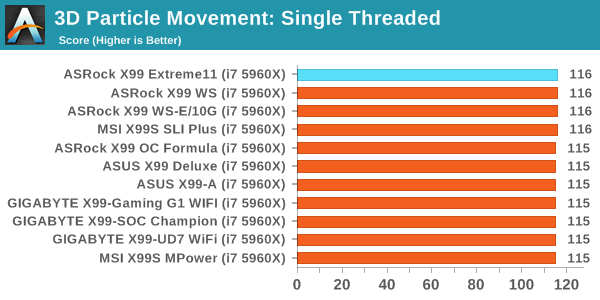
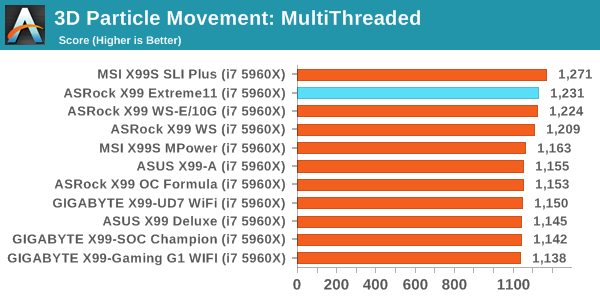
Compression – WinRAR 5.0.1: link
Our WinRAR test from 2013 is updated to the latest version of WinRAR at the start of 2014. We compress a set of 2867 files across 320 folders totaling 1.52 GB in size – 95% of these files are small typical website files, and the rest (90% of the size) are small 30 second 720p videos.
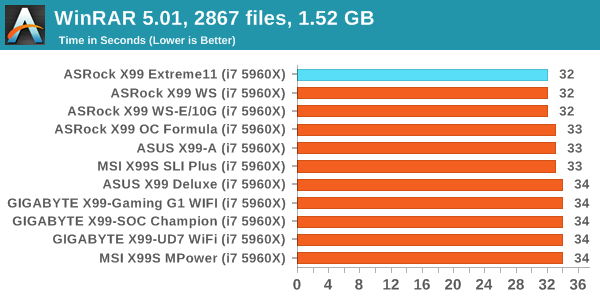
Image Manipulation – FastStone Image Viewer 4.9: link
Similarly to WinRAR, the FastStone test us updated for 2014 to the latest version. FastStone is the program I use to perform quick or bulk actions on images, such as resizing, adjusting for color and cropping. In our test we take a series of 170 images in various sizes and formats and convert them all into 640x480 .gif files, maintaining the aspect ratio. FastStone does not use multithreading for this test, and thus single threaded performance is often the winner.
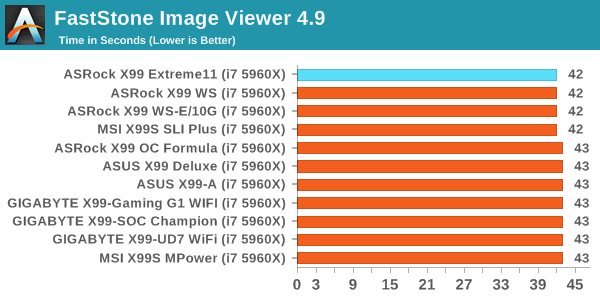
Video Conversion – Handbrake v0.9.9: link
Handbrake is a media conversion tool that was initially designed to help DVD ISOs and Video CDs into more common video formats. The principle today is still the same, primarily as an output for H.264 + AAC/MP3 audio within an MKV container. In our test we use the same videos as in the Xilisoft test, and results are given in frames per second.


Rendering – PovRay 3.7: link
The Persistence of Vision RayTracer, or PovRay, is a freeware package for as the name suggests, ray tracing. It is a pure renderer, rather than modeling software, but the latest beta version contains a handy benchmark for stressing all processing threads on a platform. We have been using this test in motherboard reviews to test memory stability at various CPU speeds to good effect – if it passes the test, the IMC in the CPU is stable for a given CPU speed. As a CPU test, it runs for approximately 2-3 minutes on high end platforms.
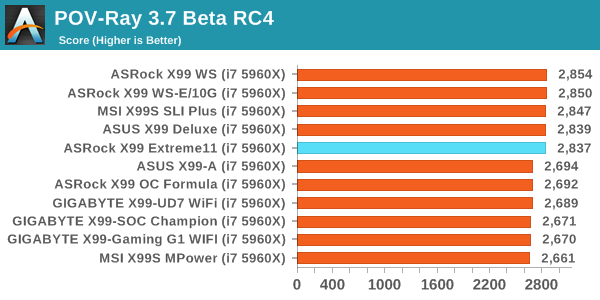
Synthetic – 7-Zip 9.2: link
As an open source compression tool, 7-Zip is a popular tool for making sets of files easier to handle and transfer. The software offers up its own benchmark, to which we report the result.
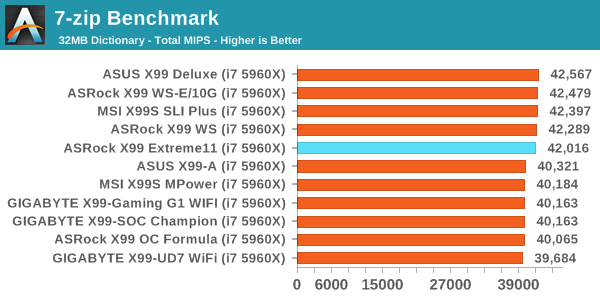










58 Comments
View All Comments
lordken - Friday, April 3, 2015 - link
Rather you should apology for being lazy. abufrejoval did run some math for you, so its pretty clear that all 18x ports wont deliver full bandwidth. If you need to run 18x SSD at full speed then you probably need server board or something.If you want to troll go elsewhere.
petar_b - Friday, January 29, 2016 - link
abufrejoval is not theoretical - 1 SSD on PCH can do 400Mb/s, but 4 SSDs simultaneously can give less 100MB/s transfer each. Now move that on SAS controller and each SSD gives 400MB/s.Once you start using SSDs on SAS - you will never go back to PCH.
I posted article a year ago on the web showing differences I have measured with crystal benchmark - values are shocking... measurements were based on ASRock X79 Extreme11, same SAS controller just CPU and RAM bit slower.
wyewye - Friday, March 13, 2015 - link
Good point duploxxx.I haven't seen a professionally done review on this site for quite a while.
petar_b - Friday, January 29, 2016 - link
Motherboard has nothing to do with gaming, go for ROG if you wish gaming. Business use, rendering, 3D where storage needs to be fast and has to be SAS.We are using older generation of the board X79 with PLX and SAS controller. There are no words nor space here to explain you what performance increase we we hook up 8 SSDs (960G) on SAS instead of Intel...
It's perfect for virtualization on or cloud realization - example: 128GB RAM + 6T SSDs can accomodate more than 20 vmware images, each with 4GB ram, running perfectly on Xeon.
@dicobalt - keeping porn ? it's so sad ppl think no further than gaming and watching tv. go buy book and learn something... mathlab, 3d studio and earn money. actually get a tv and watch porn there.
3DoubleD - Wednesday, March 11, 2015 - link
Thanks for the review! This board is incredible. I run a storage server with a software raid (Unraid) and this board alone would handle all of my SATA port needs without the need for any PCIe SATA cards. The only issue is the price though. For $600 I could easily buy a $150 Z97 motherboard with 8 SATA ports and two PCIe 8x slots, buy two $150 PCIe 2.0 8x cards (each with 8 SATAIII ports), and I'd still have money left over (probably put it towards a better case!). Also, that's not counting the significant difference in CPU and DDR4 costs.Clearly this motherboard is meant for a use case beyond a simple storage server (so many PCIe 8x slots!), so I can't say they missed their intended mark. However, I really wish they could attempt something like this on the Z97 platform, more than 10 SATA ports but with no more than two (or three) PCIe 8x slots (even if some of them are 4x). Aim for a price below $250.
I can't pretend it would be a big seller, but I know I'd buy one!
WithoutWeakness - Thursday, March 12, 2015 - link
ASRock has the Z87 Extreme11 with 22 SATA III ports (6 from chipset, 16 from LSI controller) along with 4-way SLI support (x8,x8,x8,x8) and a pair of Thunderbolt 2 ports. I'm not sure how feasible it is to plan on using all of those with only 16 PCIe 3.0 lanes from the socket 1150 CPU but it sounds like everything you're asking for. Unfortunately it came in over $500, double your asking price.I think you'll be hard pressed to get what you're looking for at that $250 mark, especially on a Z97 board. Socket 1150 CPUs only have 16 lanes and every manufacturer who is willing to put an 8+ port RAID controller on board will also want a PLX PCIe bridge chip to avoid choking other PCIe devices (GPU's, M.2 drives, etc). The RAID chip alone would bring a $100 motherboard into the $200+ range and adding the PLX chip would likely bring it to $250+. At that point every manufacturer is going to look at a board with 14+ SATA ports, a PLX chip, and a Z97 chipset and say "lets sell it to gamers" and slap on some monster VRM setup, additional USB 3.0 ports, 4 PCIe 16x lanes, bake in some margin, and sell it for $400+.
3DoubleD - Friday, March 13, 2015 - link
Makes sense. Thanks for the suggestion, I'll look into it. Not sure why I've never come across this board, doesn't seem like it is sold at any of the common outlets I shop at (Newegg.ca, ect.). Still, going the add-in SATA cards seems to be the more economical way.wintermute000 - Sunday, March 15, 2015 - link
You wouldn't have ECC with Z97.Maybe unraid is better than ZFS/BTRFS but I still wouldn't roll with that much storage on a software solution (vs HW RAID) without ECC.
Vorl - Wednesday, March 11, 2015 - link
This is such a strange board. with 18 SATA connections, the first thing everyone will think is "storage server". if all 18 ports were handled with the same high end RAID controller then the $600 price tag would make sense. As it is, this system is just a confused jumble of parts slapped together.Who needs 4 PCIE x16 slots on a storage server? That is an expense for no reason.
Who needs 18 SATA connections that are all mixed around on different controllers that can't all be hardware raided together? Sure, you can run software raid, but for $600 you can buy a nice raid card, and sas to sata breakout cards and cables, and still be ahead due to full hardware performance with cache.
Also, for a server, why would they not have the IGP port? I may be missing something, but I thought they CPU has integrated graphics.
Just not an awesome setup from what I can tell.
So.. why bother having all those sata ports if they aren't all tied to RAID?
They add an LSI controller, and that isn't even what handles RAID on the system.
1nf1d3l - Wednesday, March 11, 2015 - link
LGA2011 processors do not have integrated graphics.